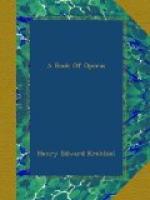righteousness of Wagner’s claim to the title
of poet than his acceptance of the Greek theory that
a people’s legends and myths are the fittest
subjects for dramatic treatment, unless it be the
manner in which he has reshaped his material in order
to infuse it with that deep ethical principle to which
reference has several times been made. In “The
Flying Dutchman,” “The Nibelung’s
Ring,” and “Tannhauser” the idea
is practically his creation. In the last of these
dramas it is evolved out of the simple episode in
the parent-legend of the death of Lisaura, whose heart
broke when her knight went to kiss the Queen of Love
and Beauty. The dissolute knight of the old story
Wagner in turn metamorphoses into a type of manhood
“in its passionate desires and ideal aspirations”—the
Faust of Goethe. All the magnificent energy of
our ideal man is brought forward in the poet’s
conception, but it is an energy which is shattered
in its fluctuation between sensual delights and ideal
aspirations, respectively typified in the Venus and
Elizabeth of the play. Here is the contradiction
against which he was shattered as the heroes of Greek
tragedy were shattered on the rock of implacable Fate.
But the transcendent beauty of the modern drama is
lent by the ethical idea of salvation through the
love of pure woman—a salvation touching
which no one can be in doubt when Tannhauser sinks
lifeless beside the bier of the atoning saint, and
Venus’s cries of woe are swallowed up by the
pious canticle of the returning pilgrims. {1}
It will be necessary in the expositions of the lyric
dramas of Wagner, which I shall attempt in these chapters,
to choose only such material as will serve directly
to help to an understanding of them as they move by
the senses in the theatre, leaving the reader to consult
the commentaries, which are plentiful, for deeper study
of the composer’s methods and philosophical
purposes. Such study is not to be despised; but,
unless it be wisely conducted, it is likely to be
a hindrance rather than a help to enjoyment. It
is a too common error of musical amateurs to devote
their attention to the forms and names of the phrases
out of which Wagner constructs his musical fabric,
especially that of his later dramas. This tendency
has been humored, even in the case of the earlier
operas, by pedants, who have given names to the themes
which the composer used, though he had not yet begun
to apply the system of symbolization which marks his
works beginning with “Tristan und Isolde.”
It has been done with “Tannhauser,” though
it is, to all intents and purposes, an opera of the
conventional type, and not what is called a “music-drama.”
The reminiscent use of themes is much older than Wagner.
It is well to familiarize one’s self with the
characteristic elements of a score, but, as I have
urged in the book quoted above, if we confine our
study of Wagner to the forms of the musical motives
and the names which have arbitrarily been given to
them, we shall at the last have enriched our minds




